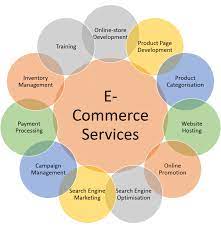In the ever-evolving landscape of business, one term has become synonymous with growth, efficiency, and adaptability: E-commerce solutions. As technological advancements continue to reshape industries, businesses are increasingly turning to e-commerce solutions to stay competitive and meet the changing demands of consumers. In this article, we will delve into the significance of e-commerce solutions, exploring key aspects such as platforms, strategies, and the transformative impact they can have on businesses.
Table of Contents
The Foundation: E-commerce Platforms

At the core of any successful e-commerce venture lies the choice of the right platform. E-commerce platforms serve as the digital marketplace where businesses showcase their products or services, facilitate transactions, and manage their online presence. Some of the leading platforms include Shopify, WooCommerce, Magento, and BigCommerce. Each platform comes with its unique features, catering to the diverse needs of businesses, whether small startups or large enterprises.
Shopify, for instance, is renowned for its user-friendly interface and ease of use, making it an excellent choice for entrepreneurs with limited technical expertise. On the other hand, Magento is preferred by businesses seeking a highly customizable and scalable solution. The choice of the platform depends on factors such as business size, product range, and long-term scalability goals.
Strategies for E-commerce Success
Having a robust e-commerce platform is just the beginning; implementing effective strategies is crucial to harness its full potential. Here are some key strategies that businesses can adopt to ensure success in the competitive e-commerce landscape:

User-Centric Design:
- Prioritize user experience with a clean, intuitive design.
- Implement responsive design to ensure seamless accessibility across devices.
Personalization:
- Leverage data analytics to understand customer preferences.
- Implement personalized recommendations and targeted marketing strategies.
Mobile Optimization:
- Recognize the growing trend of mobile commerce.
- Optimize websites for mobile users, ensuring a smooth and efficient shopping experience.
Secure Payment Gateways:
- Prioritize the implementation of secure payment gateways.
- Build trust with customers by ensuring the safety of their financial transactions.
Social Media Integration:
- Harness the power of social media for marketing and engagement.
- Integrate social media plugins to enable seamless sharing and increase brand visibility.
Streamlined Checkout Process:
- Simplify the checkout process to reduce cart abandonment.
- Implement one-click checkout options for returning customers.
Scalability and Flexibility:
- Choose a platform that allows for easy scalability as the business grows.
- Be prepared to adapt to changing market trends and customer preferences.
Transformative Impact on Businesses

The adoption of e-commerce solutions goes beyond digitizing transactions; it transforms the entire business landscape. Here are some ways in which e-commerce solutions can have a transformative impact on businesses:
Global Reach:
- Break geographical barriers and reach a global audience.
- Expand market reach without the need for physical storefronts.
24/7 Accessibility:
- Offer customers the convenience of shopping anytime, anywhere.
- Eliminate restrictions imposed by traditional business hours.
Data-Driven Decision-Making:
- Utilize data analytics to gain insights into customer behavior.
- Make informed decisions based on real-time data.
Cost-Efficiency:
- Reduce the overhead costs associated with physical storefronts.
- Optimize inventory management and reduce the need for extensive manpower.
Enhanced Customer Engagement:
- Foster direct communication with customers through various channels.
- Implement feedback mechanisms to understand and address customer needs.
Adaptability to Market Trends:
- Quickly adapt to changing market trends and consumer preferences.
- Introduce new products or services based on real-time market demands.
Challenges and Solutions in E-commerce Implementation
While the benefits of e-commerce solutions are evident, businesses must also navigate challenges associated with their implementation. Security concerns, competition, and the need for continuous innovation are among the hurdles businesses may face. However, with proactive measures, these challenges can be transformed into opportunities for growth.
Security Concerns:
- Implement SSL certificates to ensure secure transactions.
- Regularly update security protocols to protect customer data.
Competition:

- Conduct thorough market research to identify unique selling propositions.
- Differentiate the brand through a compelling online presence and superior customer service.
Continuous Innovation:
- Stay abreast of technological advancements and industry trends.
- Foster a culture of innovation within the organization to adapt to changing customer expectations.
Conclusion
In conclusion, e-commerce solutions are not merely tools for conducting online transactions; they represent a paradigm shift in the way businesses operate and interact with their customers. Choosing the right platform, implementing effective strategies, and embracing the transformative impact of e-commerce can position businesses for sustained success in the digital age. As industries continue to evolve, the adaptability and efficiency offered by e-commerce solutions will undoubtedly play a pivotal role in shaping the future of commerce.

